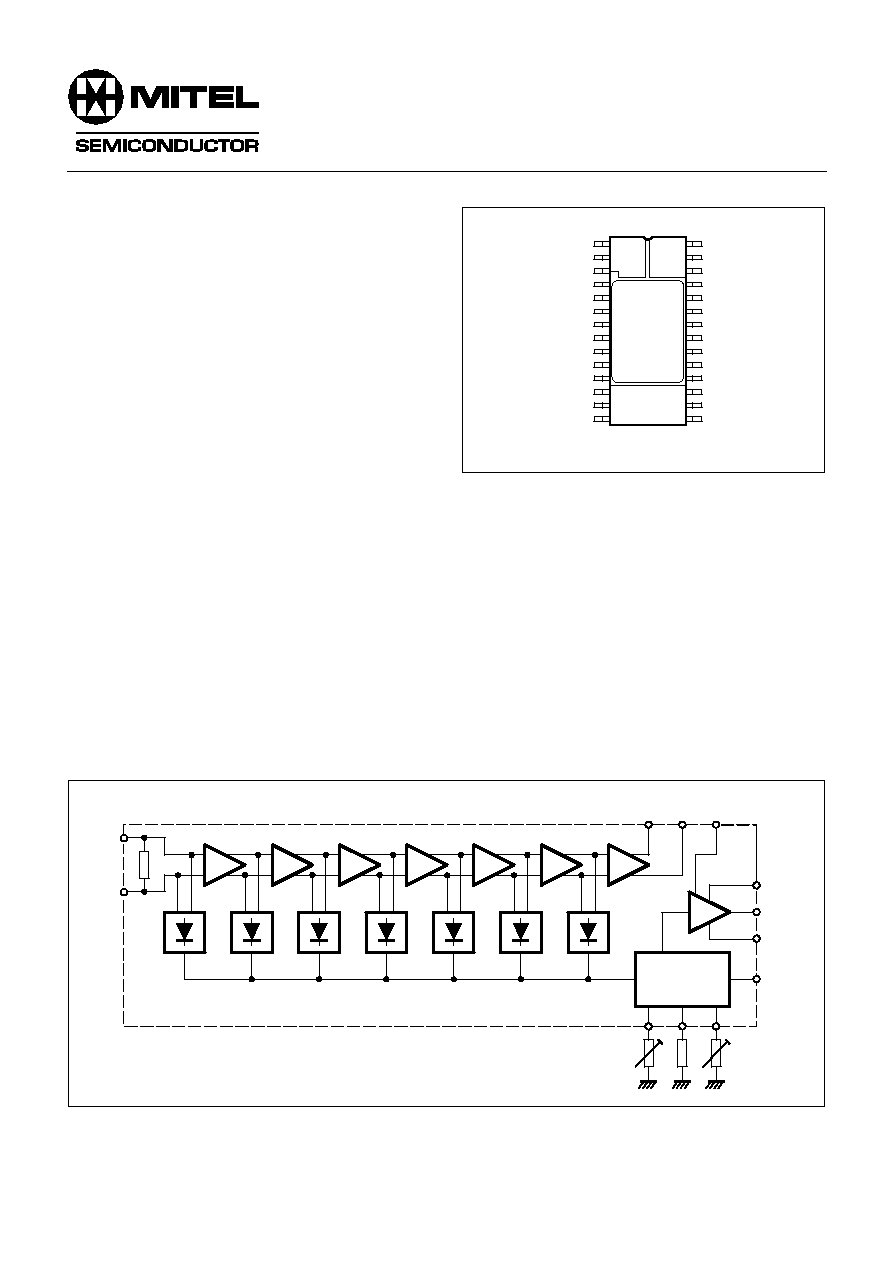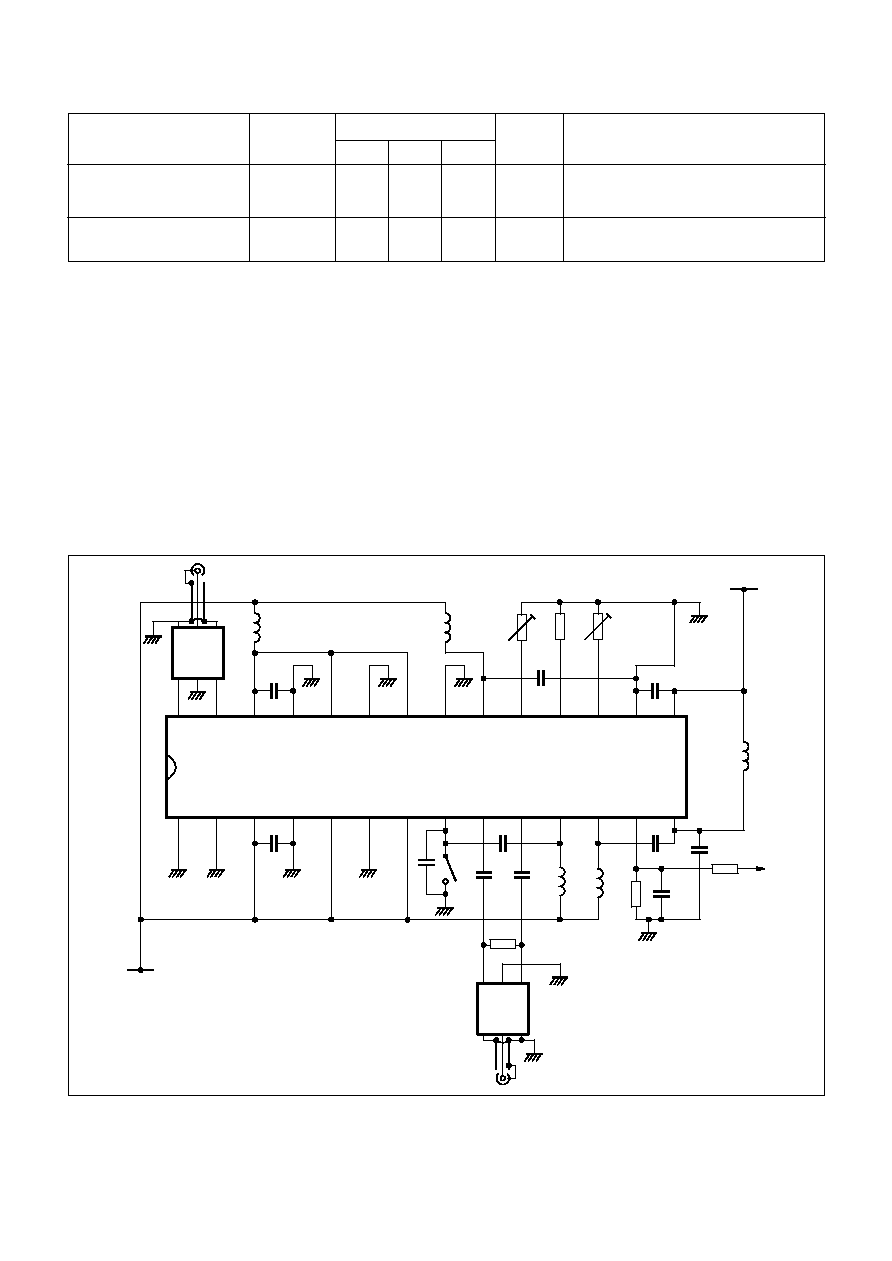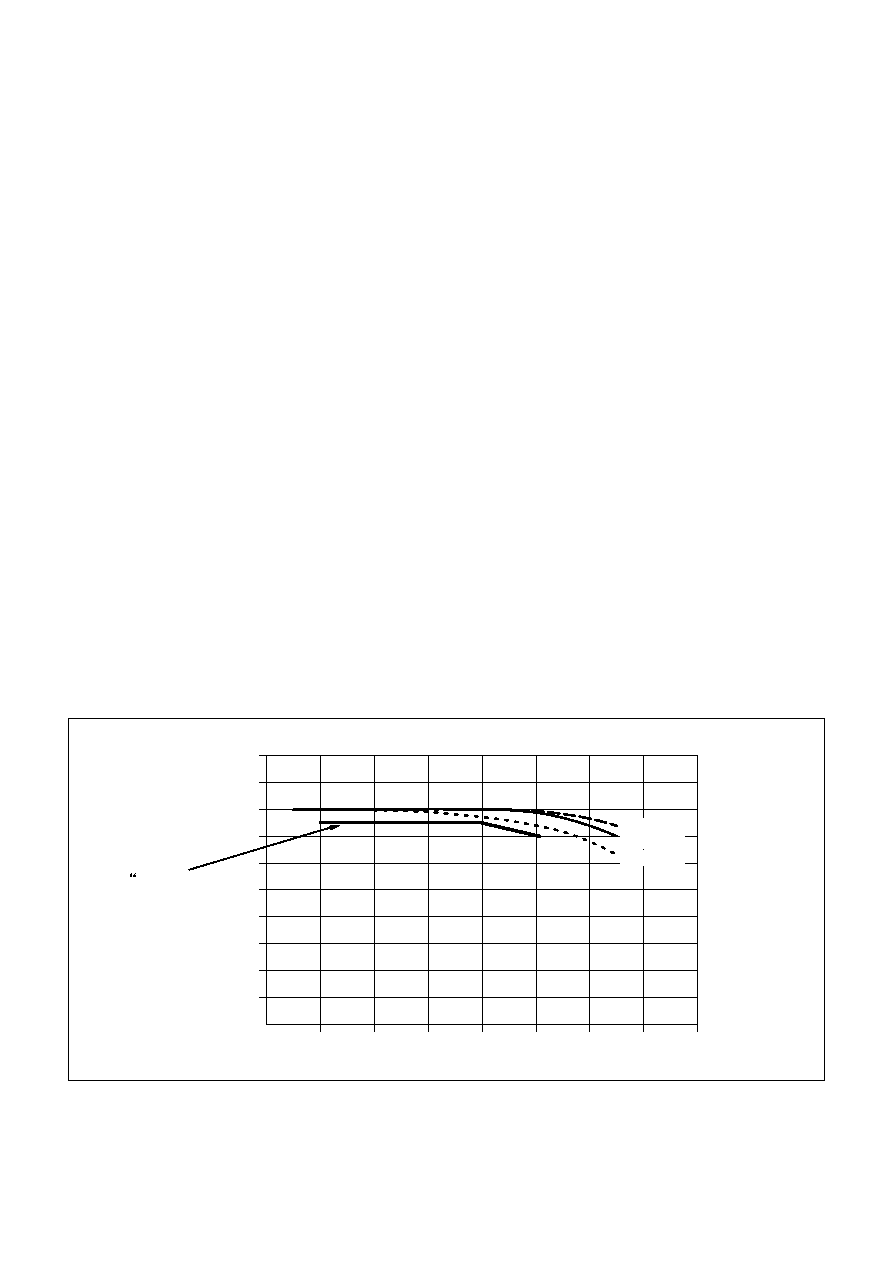
SL3522
500MHz 75dB Logarithmic/Limiting Amplifier
Advance Information
The SL3522 is a monolithic seven stage successive
detection logarithmic amplifier integrated circuit for use in the
100MHz to 500MHz frequency range. It features an on≠chip
video amplifier with provision for external adjustment of log
Slope and offset. It also features a balanced RF output. The
SL3522 operates from supplies of
±
5V.
FEATURES
s
75dB Dynamic Range
s
Surface Mount SO Package
s
Adjustable Log Slope and Offset
s
0dBm RF Limiting Output
s
60dBm Limiting Range
s
2V Video Output Range
s
Low Power (Typ. 1W)
s
Temperature Range (T
CASE
): -55
∞
C to +125
∞
C
APPLICATIONS
s
Ultra Wideband Log Receivers
s
Channelised and Monpulse Radar
s
Instrumentation
ABSOLUTE MAXIMUM RATINGS
Supply Voltage
±
6.0V
Storage temperature
-65
∞
C to +175
∞
C
Junction temperature
+175
∞
C
Thermal resistance
Die-to-case
15.5
∞
C/W
Die-to-ambient
76.5
∞
C/W
Applied DC voltage to RF input
±
400mV
Applied RF power to RF input
+15dBm
MC28
Fig.1 Pin connections - top view
Fig.2 Functional block diagram
ORDERING INFORMATION
SL3522 A MC (Miniature Ceramic package)
SL3522 C MC (Miniature Ceramic package)
SL3522 NA 1C (Probe-tested bare die)
(Also available: SL3522 AA MC screened to Mitel HI-REL
level A. Contact Mitel Semiconductor sales outlet for a
separate datasheet.)
ESD PROTECTION
To achieve the high frequency performance there are no
ESD protection structures on the RF input pins (27, 28). These
pins are highly static sensitive, typically measured as 250V
using MIL-STD-883 method 3015. Therefore, ESD handling
precautions are essential to avoid degradation of
performance or permanent damage to this device.
Supersedes edition in Professional Products IC Handbook May 1991
DS3534 - 2.0 April 1994
N/C
N/C
V
EE
GND
V
EE
GND
V
EE
RF O/P GND
RF O/P≠
RF O/P+
RF O/P V
EE
VIDEO O/P V
EE
VIDEO O/P
VIDEO O/P V
CC
RF I/P+
RF I/P≠
V
EE
GND
V
EE
GND
V
EE
GND
VIDEO V
EE
GAIN ADJUST
TRIM REF
OFFSET ADJ
VIDEO GND
VIDEO V
CC
1
28
2
3
4
5
6
7
8
9
10
11
12
13
14
27
26
25
24
23
22
21
20
19
18
17
16
15
RF
I/P +
RF
I/P ≠
27
28
9
10
14
VIDEO GAIN
AND OFFSET
ADJUST
19
18
17
GAIN
ADJ
R
G
R
T
R
O
OFFSET
ADJ
12
13
16
O/P
GND
VIDEO
OUT
O/P
V
EE
RF
O/P≠
RF
O/P+
O/P
V
CC
3, 5, 7, 20, 22, 24, 26 V
EE
4, 6, 8, 21, 23, 25 GND
VIDEO
V
CC
15

3
SL3522
15
3
Degrees
Degrees
Min.
Typ.
Max.
Phase variation with RF
Input level
Phase tracking between
units
Freq = 300MHz RF
IN
= -60 to +10dBm
See notes 2, 7
T
CASE
= +25
∞
C FREQ = 300MHz
See notes 2, 7
Units
Value
Conditions
Parameter
Pin
ELECTRICAL CHARACTERISTICS (cont.)
Notes
1 RF output buffer OFF (pin 8 disconnected from 0V)
2 RF output buffer ON (pin 8 connected to 0V)
3 Minimum dynamic range under any single set of operating conditions
4 Log linearity guaranteed for pin = -64dBm to +6dBm for ALL supply, temperature and frequency conditions
5 Full range of supply, temperature and frequency conditions
6 Input limiting range typically -50dBm to +10dBm
7 Not tested, but guaranteed by characterisation
8 Not tested, but guaranteed by design
The SL3522 CANNOT be GUARANTEED to operate below 100MHz and meet the electrical characteristics shown above.
However, characterisation has shown that the device can still function adequately down to frequencies of 50MHz, with the following
reservations:-
1)The video bandwidth is fixed to approx 40MHz a certain amount of carrier breakthrough on the video O/P (pin 13) will occur,
with input signal frequencies below 100MHz.
2)There are 2 RF coupling capacitors (20pF) on-chip, which couple the output signal from stage 3 to the input of stage 4 (ref
Fig. 24). These can introduce undesirable limiting phase performance for input signal frequencies below 100MHz.
Fig.3 Test circuit
+5V V
CC
L3
VIDEO
OUTPUT
470
18p
200
10n
OFFSET
ADJUST
R
0
2k2
10n
10n
10n
L4
L5
GAIN
ADJUST
R
G
2k2
L2
10n
1n
1n
SW1
15
16
17
18
19
20
21
22
23
24
25
14
13
12
11
10
9
8
7
6
5
4
100
6
5
4
1
2
3
ANZAC
TP101
RF OUTPUT
+5V V
EE
10n
3
2
1
26
27
28
10n
L1
1
2
3
6
5
4
ANZAC
TP101
RF INPUT
NOTES
1.
Inductors L1 to L5 = 3 TURNS
30SWG on Ferrite bead.
2.
D.U.T. mounted in a test socket
≠ ENPLAS OTS≠28≠1.27≠04
3.
Transmission line BALUNS used
≠ not recommended in Application (see Para 3C)
R
T
1k5
SL3552

4
SL3522
Fig.4 Plot showing guaranteed dynamic range v. frequency
(typical achievable dynamic range lines indicated across temperature)
PRODUCT DESCRIPTION
The SL3522 is a complete monolithic successive detection
Log/limiting amplifier which can operate over an input
frequency range of 100MHz to 500MHz. Producing a log/lin
characteristic for input signals between -64dBm and +6dBm,
the log amplifier can provide an accuracy of better than
±
1.00dB at case temperatures of -55
∞
C and +25
∞
C and an
accuracy of better than
±
1.25dB at +125
∞
C. The dynamic
range is better than 75dB over a frequency range of 100MHz
to 400MHz. The graph in fig 4 shows how the dynamic range
is guaranteed over frequency.
The SL3522 consists of 6 Gain stages, 7 Detector stages,
a limiting RF Output buffer and a Video Output amplifier. The
power supply connections to each section are isolated from
each other to aid stability.
The SL3522 consumes 1.1W of power when ALL parts of
the circuit are powered up from a
±
5.0V power supply. As the
circuit uses a differential architecture, the power consumption
of the RF gain/detector stages and RF Output Buffer will be
independent of RF input signal level. However, the Video
Output (pin 13) is driven by a single ended emitter follower and
so the power consumption of the Video amplifier will vary with
RF input signal level between pins 27 and 28.(upto 10mA over
2V video output range with max video load of 200
//20pF) The
SL3522 has a high RF gain (>50dB) across a wide bandwidth
(>450MHz) when the limiting RF Output Buffer is enabled. The
limiting RF Output Buffer provides a balanced Limited Output
level of nominally ≠1.0dBm on each RF Output connection (pin
9 and 10), for RF input signal levels on pins 27 and 28 in excess
of ≠50dBm.
The limiting RF Output Buffer can be isolated from the
other sections of the SL3522, by disconnecting the RF Output
Buffer GND (pin 8) from 0V, and leave the pin floating. This
feature aids stability in applications NOT requiring a Limited RF
Output signal, and lowers the power consumption of the
SL3522 to 0.95Watts, when the other sections are powered up
from a
±
5.0V power supply.
Each of the Gain and Detector stages has approximately
12dB of gain, and a significant amount of on-chip RF
decoupling (200pF per stage), also to aid stability. The Video
amplifier provides a positive going output signal proportional to
the log of the amplitude of an RF input applied between pins 27
and 28. The gain and the offset of the Video amplifier can be
adjusted by 3 resistors; R
G
, R
T
, and R
O
which are connected
to Gain adjust (pin 19),Trim reference (pin 18) and Offset
adjust (pin 17). With R
T
set to 1.5k
, R
G
can be set to any value
between 1k
and 2k2
and achieve a range in Video Slope of
±
20%, centred on 21mV/dB. Similarly, R
O
can be set to any
value between 1k
and 2.2K
and achieve an offset range of
±
0.5V, which should allow the Video Offset to be trimmed to 0V
if required.
The RF input pins (27 and 28) have a 50
terminating
resistor connected between them on≠chip. These are
capacitively coupled to the I/P gain stage with 20pF on-chip
capacitors. (Refer to APPLICATION NOTES section for
information on how to connect an RF input signal to the device).
0
10
20
30
40
50
60
70
80
90
100
100
200
300
400
500
600
700
800
+125
∞
C
≠55
∞
C
+25
∞
C
Minimum
guaranteed
dynamic
range (dB)"

5
SL3522
APPLICATION NOTES
1)
VIDEO≠AMPLIFIER
The SL3522 uses a single ended Video amplifier to
produce a trimmable Video transfer characteristic. Both the
gain (Slope) and Offset of the amplifier can be externally
adjusted.
a)
Gain and Offset trimming (ref Applications
circuits in figs 5 and 6)
The Gain and Offset control is achieved by adjusting R
G
and R
O
respectively. The control is dependent upon their
difference from the Trim reference resistor, R
T
. Adjustment of
Gain has an effect on Offset, but adjustment of Offset does
NOT affect the Gain. Therefore the Gain should be optimised
first. The Offset should only be adjusted once the Gain has
been set.
Fig 7 shows the variation of Video Offset with value of R
O
,
for a fixed value of R
T
and R
G
= 1k5
.
Fig 8 shows the variation of Video Slope with value of R
G
,
for a fixed value of R
T
and R
O
= 1k5
.
The Video amplifier incorporates temperature
compensation for Video gain (Slope). To ensure temperature
stability for Video gain (Slope) over the operating temperature
range, it is recommended that the resistors with identical
temperature coefficients of resistance are used for R
T
and R
G
.
The Video amplifier does NOT incorporate temperature
compensation for Video Offset. Although it is recommended
that a resistor with identical temperature coefficient of
resistance to R
T
be used for R
O
, it may be necessary to use an
additional external temperature compensating network.
b)
Video performance
The Video≠amplifier has a critically damped rise time of
16ns (10% - 90%).In order to achieve this transient
performance, it is important to ensure that:-
i) the resistor connected to Trim reference (pin 18), has a
nominal resistance of 1.5k
, with a parasitic capacitance
LESS than 5pF.
ii) the load applied to the Video Output (pin 13) does NOT
exceed 200
resistance in parallel with 20pF.
Also, the following decoupling should be incorporated:-
i) The Video Output V
CC
(pin 14) should be decoupled with
a 10nF capacitor to the RETURN line from the video load,
connected to Video GND (pin 16), avoiding any common
impedance path.
ii) The Video Output Vee (pin 12) should be decoupled
with a 10nF capacitor DIRECTLY to Video-Output V
CC
(pin
14).
2)
SL3522 AS A LOG AMPLIFIER
with RF output buffer disabled (pin 8 floating)
If the SL3522 is to be used as a Logarithmic successive
detection amplifier only, with no requirement for a limited RF
Output, the RF input (pins 27 and 28) can be driven EITHER
differentially or single ended from a 50
source. If being used
with a single ended input, the SIGNAL should be applied to pin
27 and the RETURN should be connected to pin 28, as shown
in the Application circuit diagram in Fig 5.
The SL3522 is VERY stable when used in this way.
Although not a crucial requirement, it is recommended that the
device should be mounted using a ground plane.
3) SL3522 AS A LOG/LIMITING AMPLIFIER
- with RF Output-Buffer ENABLED (pin 8 connected
to GND)
If the SL3522 is to be used as a Limiting or Log/limiting
amplifier with a requirement for a Limited RF Output signal,care
is required in the layout of components and connections around
the device to ensure stability. The following precautions should
be observed (refer to Application circuit diagram in Fig. 6):-
a) The device should be mounted on a ground plane,
ensuring that the impedance between the ground plane and
ALL the GND pins is kept as low as possible. If a multilayer PCB
is used where the ground plane is connected to the GND pins
using through-plated holes (vias), it is essential to ensure that
the vias have a very low impedance. ALL supply decoupling
capacitors should be RF chip capacitors whose leads should be
kept as short as possible.
b) The RF V
EE
connections (pins 3,5,7,11,20,22,24,26)
should be connected to a low impedance copper plane. A two
layer PCB should help to achieve this.
c) The RF input (pins 27 and 28) should be driven with a
balanced source impedance. One way of achieving this is to
use an isolating BALUN transformer (50
UNBALANCED
50
BALANCED) connected between the signal source and
the RF input pins. (e.g. Mini circuits TT1≠6, TO ≠75). The device
stability is VERY sensitive to an imbalance of the differential
source impedance at pins 27 and 28. Use of a transmission line
BALUN though, is NOT recommended.
d) The RF Output connections (pins 9 and 10) should each
be loaded with matched impedances ideally 50
transmission
lines. The RF Output lines leading away from the device should
be balanced. Driving highly reactive SWR loads is NOT
recommended as these can encourage device instability, as
can an imbalance of the differential load impedance at pins 9
and 10.
e) The RF Output connections (pins 9 and 10) are DC
coupled, and ideally the output pins should be capacitively
coupled to their loads using 1nF capacitors. However the RF
Outputs can drive a DC load to GND and a DC offset of approx.
400mV will exist on each RF Output pin. IT WILL NOT BE
POSSIBLE TO DISABLE THE RF OUTPUT BUFFER UNDER
THESE CONDITIONS.
f) The RF output (pins 9 and 10) has a tendancy to limit on
self noise, particularly at low ambient temperatures (-55
∞
C),
when the RF output buffer is enabled.
NOTE that this will effect the liminting range as the gain of the
RF output buffer will reduce as the amount of noise limiting
increases.
If required the limited RF Output can be attenuated using
an attenuation network as shown in fig. 9. Under these
conditions the effective RF Output currents will be reduced,
allowing the device to operate with a greater margin of
stability.It may be possible to run the device without a BALUN
transformer on the RF input if the total output impedance on the
RF Output >> 50
, and the attenuation components are
mounted as close as possible to the RF Output connections
(pins 9 and 10). The RF input connection could then be
configured as in Fig 5.




